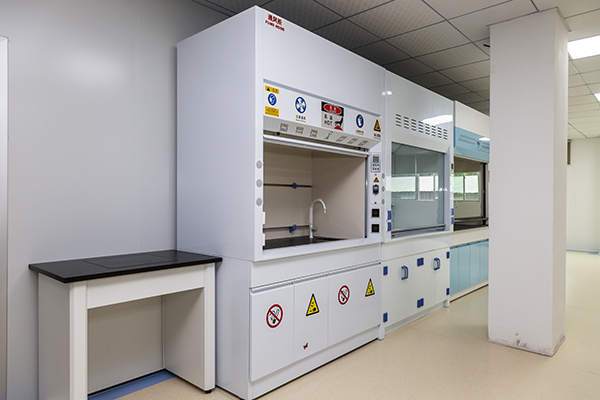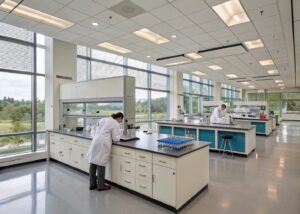Chemistry lab fume hoods play an essential role in any laboratory, keeping staff safe from toxic chemicals by providing a ventilation system.
The primary function of a laboratory fume hood is to expel any potentially harmful substances such as fumes, aerosols, gases, vapors, and dust. When chemical reactions take place, they create barriers between laboratories.
However, for the fume hood to provide this critical measure of protection, it must be used effectively and correctly by lab staff. Here are some tips to ensure your laboratory fume hood is adequately protected from the hazards of toxic fumes, chemical spills, and dangerous reactions.
Minimize Air Turbulence
Airflow disturbances can reduce the efficiency of the fume hood. This is why finding the right location is crucial to maintaining good working conditions.
After installing the fume hood, place it where cross-draft can be avoided. It includes:
1. Staff Mobilisation
2. Door opening and closing
3. Windows
4. Supply air diffuser
5. External fan
While avoiding high-traffic areas is vital to ensure maximum contaminant control, so is the movement of laboratory workers around the fume hood. Avoid rapid activities in and out of the fume hood, which may cause air disturbances.
Make Sure The Exhaust Is Normal
Laboratory staff should always ensure proper exhaust before starting work. Expelling fumes is the primary job of the fume hood, so if this part of the ventilation system is not working, the fume hood will not function effectively.
Check the flapper when making sure the exhaust is working. Removable partitions create openings in the rear of the fume hood. They maintain uniform airflow, which increases efficiency. Check for any obstructions that may be blocking airflow.
Also, if the chemistry lab fume hood includes an airflow monitor, check the monitor’s status regularly. Ensuring it’s functioning correctly will allow you to better fit for any suspicious airflow changes.
Standard Operation Procedures
Even in equipment with unique fume hood designs, high efficiency can only be achieved if the equipment is used effectively. Therefore, following proper operating procedures is vital.
Each type of fume hood has its own manufacturer’s instructions and procedures. However, examples of reasonable laboratory fume hood procedures typically include the following:
When you have large equipment inside the fume hood, place shelves under the equipment so that air can flow under it.
Keep the fume hood closed at all times unless commissioning equipment or working in a fume hood.
Place any containers or equipment 6 inches away from the fume hood surface.
To maximize performance, keep fume hood sashes closed as much as possible. In the event of a power outage, lower the fume hood sash to within 1 inch. Allowing some air to continue to flow into the fume hood creates a chimney effect.
Special Attention
Such as paper products, chemical wipes, and aluminum foil. Lightweight materials such as these can quickly be drawn into the exhaust and obstruct airflow.
If using a tabletop fume hood, use a sliding sash barrier. It protects you and keeps your face out of the work area.
Priority Management and Maintenance
Proper internal management and updated maintenance procedures are critical to ensuring that your laboratory fume hood operates efficiently and at high performance.
Some internal management and maintenance procedures that should be implemented include:
1. Do not store items (including chemicals) in a fume hood. Not only do they block airflow, but they can also interfere with pollutant control. The fume hood manufacturer recommends keeping at least 50 percent of your workbench clean.
2. Store hazardous chemicals in an approved safety storage cabinet. If the operation requires chemicals, keep only the minimum amount in the fume hood. Biological safety storage cabinets have different functions and are specifically designed to prevent exposure to biological materials. Therefore, using the correct enclosure for a specific chemical or biological material is important.
If you operate a ductless fume hood, be sure to check your fume hood filters to make sure they are clean or if they need replacing. When cleaning, carbon filters play an essential role in removing harmful fumes and particles from the laboratory.
Not only should the fume hood be assessed for airflow obstruction before use, but excessive turbulence should also be considered. Fume hood certification is required at least annually to ensure safe operation. Typical tests might include face wind tests and smoke tests. The certification organization will also conduct tracer gas control testing. These tests are crucial because face velocity does not always accurately predict leaks in fume hoods.
Clean up spills immediately. If splashing occurs, be sure to wipe the liquid off the fume hood glass.
Summary
If your chemistry lab fume hood is not functioning properly, contact the manufacturer immediately so your fume hood can be tested. Proper maintenance is key to ensuring your laboratory fume hood continues to function effectively and keeps working staff safe from hazardous reactions and toxic fumes.




